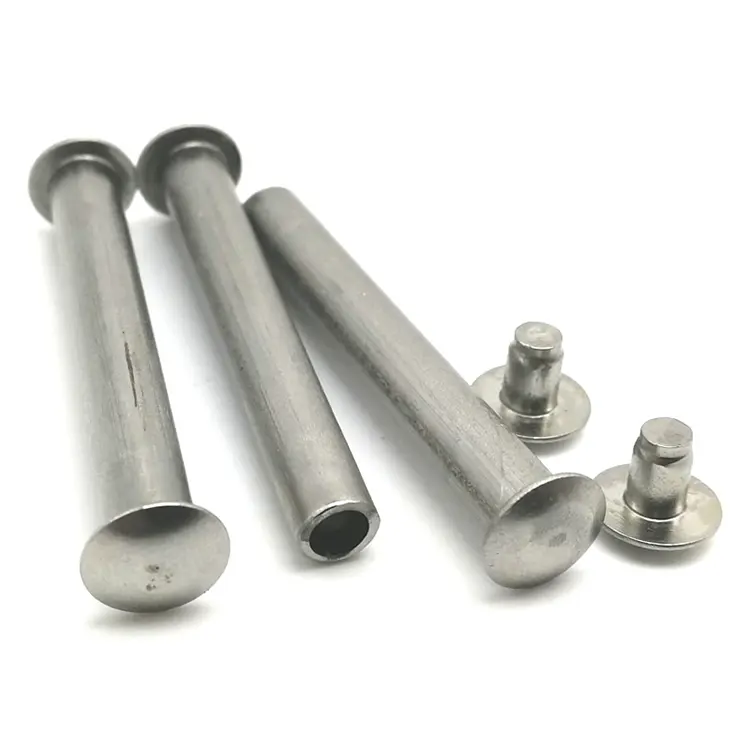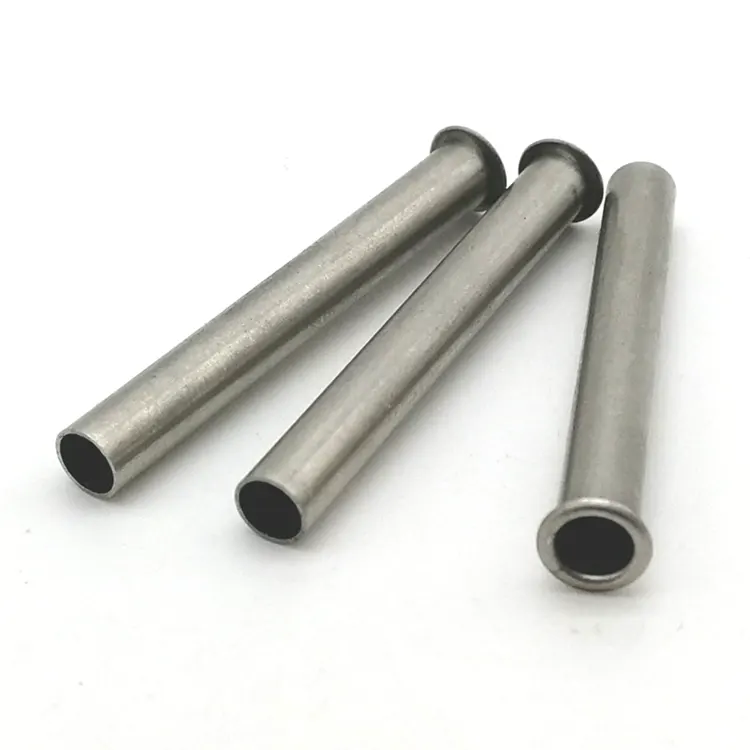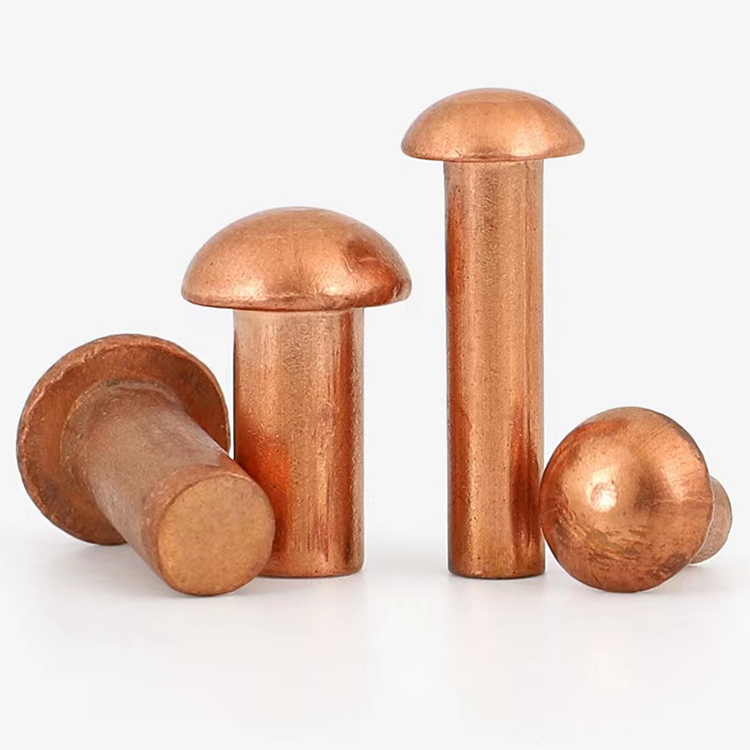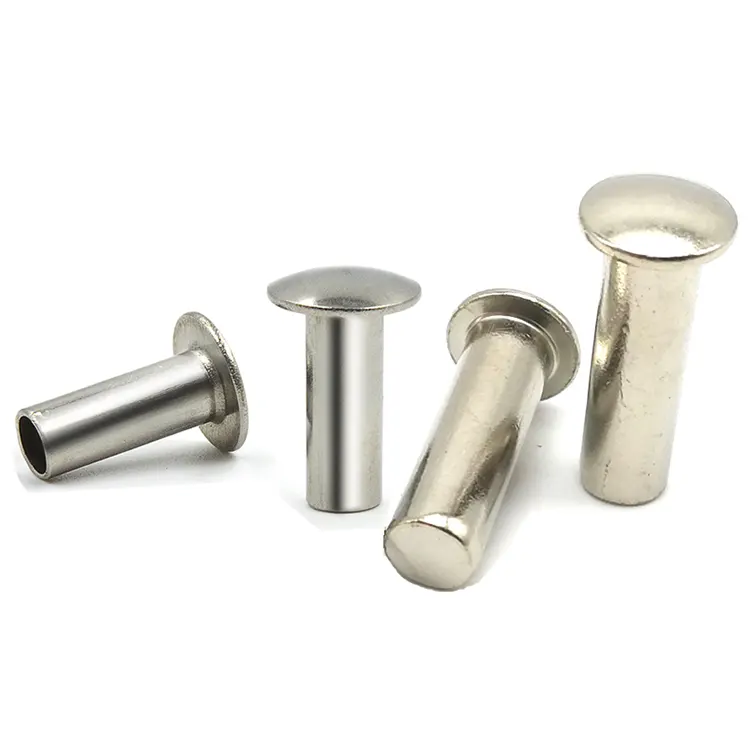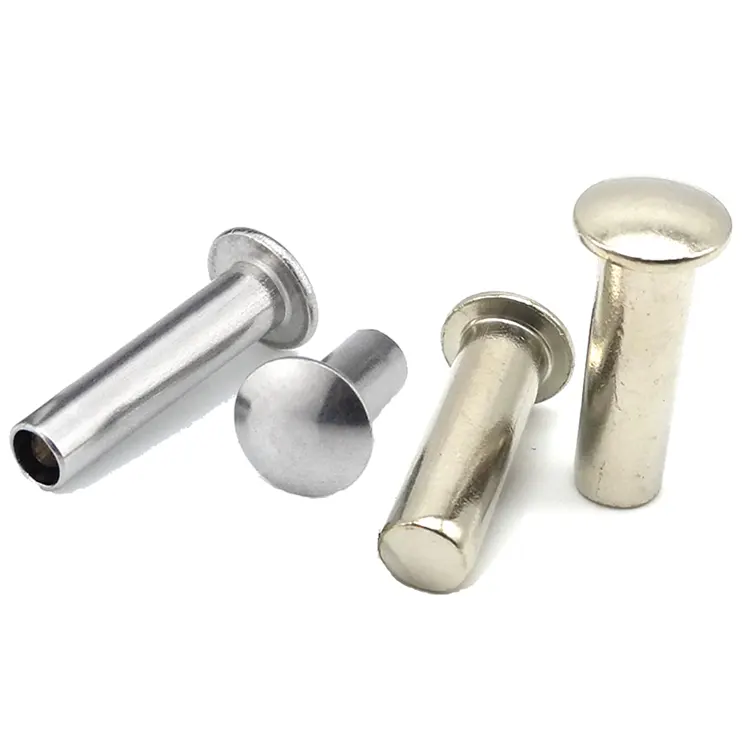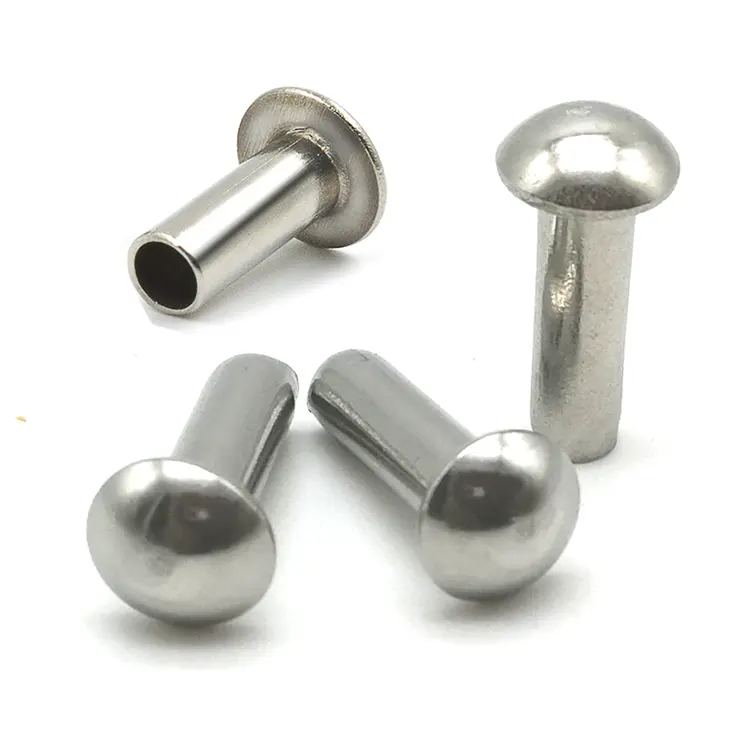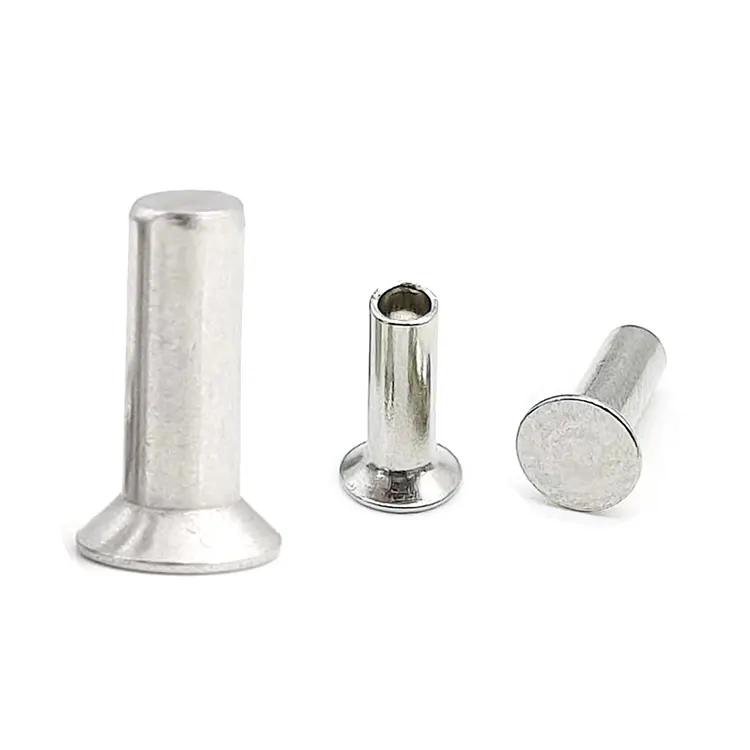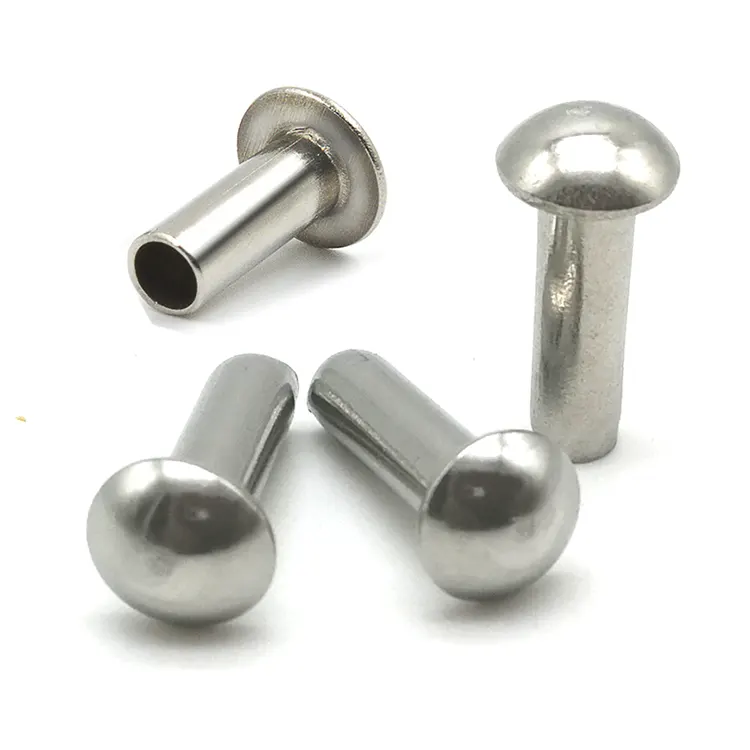Rivetti
As one of professional manufacturer in China, Notin would like to provide you Rivets. And we will offer you the best after-sale service and timely delivery.
What is a rivet?
A rivet is a permanent mechanical fastener used to join two or more materials. Rivets work by inserting a metal pin into an aligned hole and deforming the end, creating a strong, secure, and durable connection. Unlike temporary fasteners like screws, rivets do not rely on threads, but instead form a permanent connection, making them ideal for applications requiring high strength, durability, and vibration resistance.
Classification of Rivets
Rivets are typically categorized by head shape, degree of hollowness, or material.
Based on head shape, rivets can be classified as flat head rivets, round head rivets, countersunk head rivets, mushroom head rivets, universal head rivets, truss head rivets, etc.

Based on degree of hollowness, rivets can be classified as solid rivets, semi-tubular rivets, or full tubular rivets.
Based on material, rivets can be classified as brass rivets, stainless steel rivets, steel rivets, aluminum rivets, copper rivets, etc.
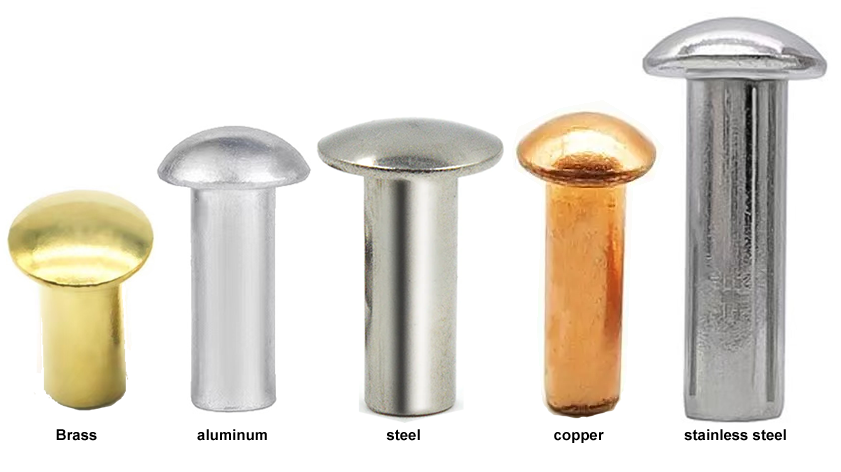
What surface finishes are available for rivets?
Rivet surfaces are typically treated with rust-proofing treatments, primarily electroplating, including zinc plating, nickel plating, chrome plating, tin plating, gold plating, and silver plating. Electroplating is a common rust-proofing method for rivets. It applies a layer of plating to the rivet surface through physical or chemical methods. The plating effectively prevents corrosion and rust, while also providing a certain aesthetic effect.
Another special surface treatment method is head coating. Head coating is performed after the rivet is electroplated. This allows for a variety of colors on the rivet head, achieving an aesthetically pleasing finish.
Aluminum rivets cannot be electroplated, but they can be anodized. Anodizing also allows for a variety of color options, but the unit price is higher than electroplating.
Rust-proofing the rivet surface is crucial, effectively extending the rivet's service life and ensuring a secure connection. Different rust-proofing methods are suitable for different environments and applications, so the choice should be tailored to the specific situation.
- View as
Rivetti in acciaio
I rivetti in acciaio al carbonio sono un elemento di fissaggio meccanico comune utilizzato in un'ampia varietà di prodotti industriali e di uso quotidiano. La loro funzione principale è collegare in modo sicuro due o più componenti insieme, creando una struttura stabile. I rivetti in acciaio al carbonio sono apprezzati per la loro resistenza, durata e convenienza. Nuote Metals produce rivetti in acciaio al carbonio da oltre un decennio. Situata a Dongguan, in Cina, conosciuta come la "Fabbrica del mondo", diamo il benvenuto ai visitatori di tutto il mondo che vengono a trovarci.
Per saperne di piùInvia richiestaRivetti a testa cilindrica in acciaio
I rivetti a testa cilindrica in acciaio sono un elemento di fissaggio industriale comune utilizzato in un'ampia gamma di applicazioni, tra cui l'industria automobilistica, l'aviazione e l'edilizia. Nuote Metals è specializzata nella produzione di rivetti a testa bombata in acciaio, venduti in tutto il mondo. Offriamo una vasta gamma di rivetti realizzati in vari materiali, tra cui ottone, acciaio inossidabile, alluminio e rame. Possiamo anche personalizzare i nostri prodotti con vari trattamenti superficiali, come galvanica, decapaggio e anodizzazione, per soddisfare le esigenze del cliente.
Per saperne di piùInvia richiestaRivetti a testa di fungo in acciaio
I rivetti a testa a fungo in acciaio, noti anche come rivetti a testa bombata, sono ampiamente utilizzati nelle applicazioni industriali. La loro esclusiva forma a testa di fungo e la struttura in acciaio forniscono una connessione sicura e affidabile per una varietà di strutture. Nuote Metals è specialista in rivetti a testa a fungo in acciaio. I nostri rivetti sono venduti in tutto il mondo e hanno ottenuto riconoscimenti da parte di clienti nazionali e internazionali. Accogliamo con favore le vostre richieste e l'opportunità di servirvi.
Per saperne di piùInvia richiestaRivetti a testa piatta in acciaio
I rivetti a testa piatta in acciaio collegano saldamente i componenti attraverso la deformazione o l'accoppiamento con interferenza, garantendo che rimangano inseparabili e adatti ad applicazioni soggette a carichi generali. Possono anche essere rifiniti con nichel, zinco bianco, zinco blu, zinco nero, zinco colorato, rame o cromatura per adattarsi a vari ambienti ed esigenze estetiche. Nuote Metals è specializzata nella produzione di rivetti a testa piatta in acciaio, con spedizione in tutto il mondo. Sono benvenuti anche gli ordini personalizzati.
Per saperne di piùInvia richiestaRivetti a testa svasata in acciaio
I rivetti a testa svasata in acciaio sono un elemento di fissaggio comunemente utilizzato per collegare due o più pezzi. Vengono fissati ai pezzi mediante martellamento o forza meccanica, creando una connessione sicura. Nuote Metals è un'azienda specializzata nella produzione di rivetti a testa svasata in acciaio, con sede a Dongguan, in Cina, una città con una fiorente industria. I nostri rivetti presentano una superficie liscia e priva di bave, una placcatura impeccabile e giunti senza crepe. Diamo il benvenuto a richieste e ordini.
Per saperne di piùInvia richiestaRivetti a testa tonda in acciaio inossidabile
I rivetti a testa tonda offrono un'eccellente resistenza alla corrosione. Ciò è particolarmente vero per i rivetti a testa tonda in acciaio inossidabile 304, che sono realizzati in acciaio inossidabile 304, un materiale rinomato per la sua eccellente resistenza alla corrosione, buona lavorabilità e finitura esteticamente gradevole. L'acciaio inossidabile 304 resiste all'attacco di un'ampia gamma di sostanze chimiche, rendendolo ideale per l'uso in ambienti umidi e corrosivi. Di conseguenza, i rivetti a testa tonda in acciaio inossidabile 304 offrono una maggiore durata in ambienti esterni o umidi, sono meno soggetti alla ruggine e offrono bassi costi di manutenzione.
Per saperne di piùInvia richiestaWhat are the advantages of rivets over other fasteners?
1. Ease of Installation
Rivets are fast to install, and even fully automated for high-volume applications, resulting in a simple and efficient operation process.
2. Connection Reliability
The riveting process is standardized, with strict quality control, resulting in highly stable connections. Visual inspection allows for quick verification of connection quality.
3. Vibration and Impact Resistance
Rivets connect through deformation or interference fit, providing strong clamping force and excellent vibration resistance, capable of withstanding vibration and shock.
4. Low Cost
Rivets are easy to install and can be fully automated, saving significant labor costs.
What are the advantages and disadvantages of rivets made of different materials?
Aluminum Rivets
Advantages: Lightweight, reduces overall product weight, low cost, suitable for general civilian applications.
Disadvantages: Low tensile and shear strength, unsuitable for high-strength workpieces, prone to electrochemical corrosion when in contact with metals such as stainless steel.
Stainless Steel Rivets
Advantages: Strong corrosion resistance, high hardness, suitable for high-strength workpieces (such as marine equipment)
Disadvantages: Higher cost, typically more expensive than aluminum rivets of the same specification.
Brass and Copper Rivets
Advantages: Excellent conductivity (such as connecting electronic components), good corrosion resistance.
Disadvantages: Higher cost, more difficult to process.
Steel Rivets
Advantages: High hardness, high connection reliability, and wide applicability.
Disadvantages: Compared to other materials, iron rivets are more prone to rusting.
What are the main applications of rivets?
Rivets have a wide range of uses, from small items like a pair of scissors to large items like airplanes and ships, as well as in high-precision medical applications.
Industrial Manufacturing
Rivets are used in a wide variety of industrial fields, wherever there is a need to connect two or more materials.
Electronics
Rivets secure heat sinks and chips, providing both vibration damping and noise reduction, and are widely used in the cooling systems of electronic products such as computers and mobile phones.
Automotive
Rivets are widely used to connect components of automobile bodies and chassis, such as doors and hoods. Their lightweight and corrosion-resistant properties make them an indispensable joining method in automotive manufacturing.
Aerospace
In aircraft manufacturing, rivets are used to connect different fuselage components, such as wings and tailplanes. Millions of rivets create high-strength, corrosion-resistant joints. Aluminum and titanium alloy rivets are often used to connect components of corresponding materials, ensuring stability in extreme environments.
Rivets are used everywhere. The above examples only represent a small number of their applications. We see rivets everywhere in our daily lives, such as on scissors, folding beds, and strollers etc. Rivets can be customized to different sizes and materials depending on the application.
Nuote Metals has specialized in the rivet industry for over a decade. Our factory is located in Dongguan, a city known as the "World Factory," a city with a developed industry and convenient transportation. This allows us to respond quickly when acquiring raw materials and supporting surface treatments, meeting our customers' needs for quick access to samples and bulk orders. We produce 10 million rivets daily and have molds of various specifications, allowing us to produce rivets as small as 0.8mm and as large as 10mm. We welcome your inquiries and visits.

